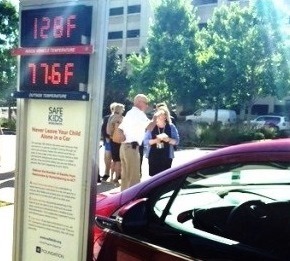















NHTSA and Safe Kids Worldwide encourage parents and caregivers to take proactive steps in preventing child heatstroke in hot vehicles |
|---|

|
National Highway Traffic Safety Administration
July 31, 2015
NHTSA 39-15
Friday, July 31, 2015
Contact: José Alberto Uclés, 202-366-9550, Public.Affairs@dot.gov
OXEN HILL, MD – As part of National Heatstroke Prevention Day, the U.S. Department of Transportation’s National Highway Traffic Safety Administration (NHTSA) joined Safe Kids Worldwide in urging parents and caregivers to take proper precautions to prevent child heatstroke tragedies in hot vehicles. NHTSA also unveiled a new technical report to help manufacturers develop effective technology innovations to prevent the dozens of child heatstroke deaths that occur each year.
NHTSA Administrator Mark Rosekind and Safe Kids Worldwide President and CEO Kate Carr delivered remarks during the Safe Kids Worldwide Childhood Injury Prevention Convention, which brought together injury prevention professionals from across the United States and around the world to discuss, share and learn ways of reducing all types of injuries to children.
“Everything we know about these needless tragedies indicates heatstroke in hot cars can happen to any parent from any walk of life," said U.S Transportation Secretary Anthony Foxx. “The Department of Transportation is providing research and technical support to bring technology to bear on this tragic problem. But we all have a role to play, by taking practical, effective measures to protect our own kids and by calling 911 if we see a child in distress.”
Leaving a child unattended in a vehicle can lead to heatstroke and can kill in minutes. Data from the San Jose State University Department of Geosciences show at least 31 children in the United States lost their lives in 2014 after being left unattended in or around vehicles, and an unknown number of others were moderately to severely injured. So far this year, there have been at least 11 child deaths from heatstroke.
“Every heatstroke death caused by leaving a child unattended in a hot car is 100 percent preventable,” said NHTSA Administrator Mark Rosekind. “The message is simple: never leave a child alone in a vehicle and always check the back seat before walking away. As a bystander, if you see a kid alone in a hot car, take action. Working together, we can prevent these tragedies.”
“We don’t want to see this tragedy happen to any family,” Karr said. “We’re asking everyone to help protect kids from this very preventable tragedy by spreading the word on National Heatstroke Prevention Day. Whether you’re a parent, caregiver or a concerned bystander, you can help save lives.”

Vehicles heat up quickly, and not even a window rolled down two inches can prevent that. The temperature inside a vehicle can reach deadly levels in only 10 minutes if the outside temperature is in the low 80 degrees Fahrenheit. Even with temperatures in the 60s or 70s, heatstroke poses a serious risk. A child will die of heatstroke once their body temperature reaches 107 degrees.
Reggie McKinnon, who lost his daughter, Payton, to heatstroke on March 8, 2010 in Cape Coral, FL said at the press event, “I made a promise to my sweet Payton that I would do everything I could to prevent this horror from ever happening to another child. And that’s what we’re doing today by coming together to bring awareness and education to such an important issue. All of us working together and pledging to never stop talking, teaching and caring.”
Since 2012, NHTSA has produced annual “Where’s Baby? Look Before You Lock” awareness campaigns during warm-weather months to alert parents and others to the dangers of heatstroke. The campaign uses radio and online advertising and provides awareness materials to safety stakeholders to spread the word.
In addition, NHTSA’s Office of Vehicle Safety Research is working to help develop technology solutions that could prevent heatstroke deaths. The agency released a technical report today that is intended as a roadmap to help manufacturers design electronic reminder systems. While a number of such systems are now available, either as features on child safety seats or as add-on products, their capabilities and ease of use vary. NHTSA’s technical report includes descriptions of system features and offers detailed test procedures product developers can use to evaluate their products.
While NHTSA encourages innovative solutions to this one hundred percent preventable tragedy, it also encourages families to maintain vigilant parenting/caregiving practices and not rely on any single safeguard against leaving a child unattended in a vehicle.
DOT and NHTSA urge parents and caregivers to take the following precautions to prevent heatstroke incidents from occurring:
Safe Kids Worldwide supports NHTSA’s heatstroke education campaign, "Where's Baby? Look Before You Lock" and the increased national coordination on the issue. In addition, to help prevent these tragedies, Safe Kids, with the support of General Motors, created Never Leave Your Child Alone in a Car as part of its Buckle Up program, a national initiative established 18 years ago to keep children and families safe in and around cars.
For more information on how to prevent child heatstroke in vehicles, visit safercar.gov/heatstroke or safekids.org/heatstroke.
Stay connected with NHTSA: Search for open recalls with VIN look up | Download the Safercar Mobile App for Apple or Android devices | Receive recall alerts by email | Visit us on Facebook.com/NHTSA | Follow us on Twitter.com/NHTSAgov | Watch 5-Star Safety Ratings crash tests on YouTube.com/USDOTNHTSA | SaferCar.gov
